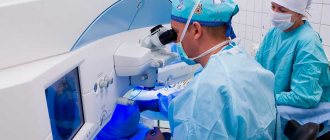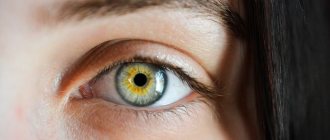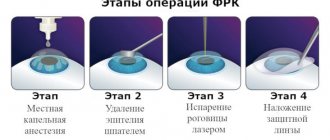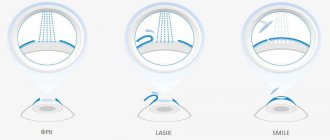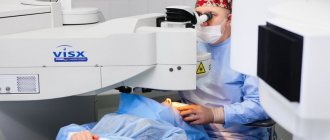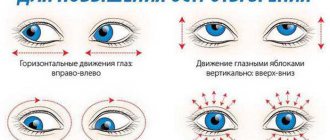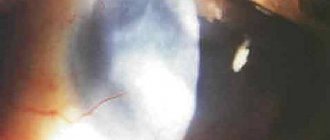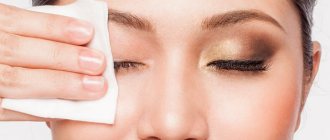Modern ophthalmology has developed unique methods for restoring vision. High-precision equipment using laser energy allows not only to carry out safe operations, but also to significantly improve visual acuity. Zero percent complications and excellent results speak for themselves. However, it is not enough to simply restore visual acuity; it is important to maintain this result, and for this you should follow the recommendations of an ophthalmologist. Although the surgical process itself only takes a few hours and the patient can soon resume their daily routine, laser vision correction does have certain limitations on what not to do.
Types of laser vision correction
It is important for patients who decide to undergo such an operation to know:
- What are the features of the rehabilitation period;
- What restrictions exist and how long to adhere to them;
- How to behave immediately after surgery so that the postoperative period passes without consequences and complications.
Several methods of laser vision correction have been developed:
- Photorefractive keratectomy (PRK), the corneal layer is removed with an excimer laser beam, and the epithelium and Bowman's membranes are removed mechanically;
- LASIK – an excimer laser beam is used, in combination with a femtosecond laser, a neat cut is achieved;
- ReLEx is a minimally invasive laser correction using a refractive beam, the only “cold” method of influencing the cornea of the eye, in which the power of the beam energy and the solution of protectors that protect the eyes from the harmful effects of laser radiation are calculated.
Each method of such correction differs in the type of laser equipment used, the duration of the rehabilitation period, and possible side effects.
Patient Reminder
HOW TO PREPARE FOR THE OPERATION?
List of tests to prepare for surgical treatment:
(test results are valid for three months from the date of delivery)
• blood test for syphilis, HIV, hepatitis B and C
Please note that it is recommended to completely stop wearing soft contact lenses 2 weeks before surgery. Depending on the results of the examination or when wearing rigid or orthokeratology lenses, a longer period of contact lens weaning may be required, in some cases up to 6 months or more.
2 days before surgery, do not use eye makeup and wash your face thoroughly; on the day of surgery, do not wear strong-smelling perfumes.
On the day of the operation, have a hearty breakfast, dress in comfortable clothes (with a wide collar or with a zipper/buttons), do not forget your documents, money, dark glasses, painkillers, change of shoes and come to the Clinic at the specified time.
HOW TO BEHAVIOR DURING THE OPERATION?
Vision correction surgery is a virtually painless procedure, the doctor will warn you about each stage and possible unpleasant sensations. We ask you to listen carefully to the surgeon and comply with his requests.
HOW TO BEHAVIOR AFTER THE OPERATION?
To ensure that the postoperative period passes without complications and as quickly as possible, follow the advice of specialists.
On the first day after surgery:
• Always wear dark glasses (including at night). Sleep on your back.
• Do not rub or touch the operated eye, eyelids, upper half of the face, wipe away tears with disposable paper handkerchiefs, touching the skin no higher than the wing of the nose
• Do not forget to instill drops according to the scheme that the doctor will give you after the operation
Further:
• Driving is allowed 1 – 2 days after surgery
• The use of decorative eye cosmetics is possible 1 week after surgery
• In the first week after laser vision correction, it is recommended to limit close-range activity: reading, writing, computer to a minimum (10–15 minutes with long breaks). In the future, it is necessary to observe “vision hygiene” - alternating work at close range (40-45 minutes) with 10-15 minute breaks, during which you need to look into the distance.
• Visiting the sauna, steam baths, swimming pool, lifting weights (more than 10 - 20 kg), playing sports and active physical activity, as well as drinking alcoholic beverages must be avoided for 1 month
• Contact sports during operations with valve formation (LASIK, Femto-LASIK) are allowed after 1 year, after the ReLEx SMILE operation - after 2 weeks
The key to successful treatment is regular instillation of drops according to the scheme recommended by your surgeon.
Features of photorefractive keratectomy, restrictions after surgery
PRK is the first technique using an excimer laser. High precision laser exposure to the layers of the cornea allows you to achieve good results and reduce side effects. The entire procedure is carried out in a “one day” mode without anesthesia:
- Anesthetic drops are instilled into the patient;
- To prevent the patient from blinking, an eyelid dilator is installed;
- The patient directs his gaze to the luminous point;
- Under the influence of an excimer laser, the ophthalmologist forms a new layer of the cornea;
- Upon completion of the operation, the eye is washed with a special anti-inflammatory solution, since during the operation the epithelium and Bowman's membranes are damaged.
PRK (PRK) or Trans-PRK (transepithelial)
The second most popular additional correction method after SMILE. In photorefractive keratetomy, the excimer laser is applied to the surface of the cornea after the epithelium is removed chemically/mechanically or using the same laser (Transepithelial PRK).
The advantages of this method of additional correction are ease of execution and low cost of the operation.
The disadvantages include a long recovery period and low accuracy when correcting small residual diopters (0.5-0.75D), because The final refraction is affected by the thickness of the epithelium growing over the evaporation zone, which cannot always be predicted.
Fig. 2 Scheme of additional correction using PRK method
A limitation to the use of the technique may be the residual thickness of the cornea of 350 microns, which does not allow removing high diopters that remain, for example, due to errors in entering calculations by an ophthalmic surgeon or engineer (yes, this is rare, but it happens!) into the laser installation.
These two methods (CIRCLE or PRK) make up the majority of corrections of residual refractive errors after SMILE. The rest can be said to be a tool of choice in the surgeon’s arsenal, which is used in “non-standard” cases.
Restrictions after PRK
Any operation, no matter what organ it is performed on, requires following the doctor’s recommendations. Since damaged epithelium will cause discomfort and pain, and epithelization will only be completed on days 4-5, it is important to follow the recommended “drip regimen”. To relieve discomfort, the patient is recommended to wear therapeutic lenses. To avoid infection, the patient after surgery should not touch his eyes, wash his face or wash his hair. For the first night, it is recommended to sleep with a blindfold.
After vision correction, you should not dive or swim for three months, you should avoid direct sunlight, and it is better to avoid traveling to hot countries and visiting a solarium.
This correction method is recommended for athletes, pilots, and military personnel, since, unlike LASIK, after photorefractive keratectomy you can play sports and subject the body to heavy physical activity. After 3-4 days, patients can start working.
After laser correction ReLEx SMILE (SMILE)
The SMILE technology does not imply the formation of a flap, and therefore epithelization of the cornea occurs the very next day after surgery. With SMILE, there is no danger of the flap shifting (flop), so rub your eyes, wear clothes with a narrow neck, etc. You can do it the very next day after surgery!
Most of the above restrictions are lifted on the second day, after a follow-up examination with a doctor. 48 hours after SMILE, the patient can:
- Apply cosmetics
- Swim in swiming pool
- Play sports, etc.
However, the use of drops prescribed by a doctor remains mandatory (the name of the drugs, frequency and duration of use is determined individually in each clinic).
Features of correction according to the LASIK program, restrictions after surgery
LASIK correction is more modern and is carried out in two stages. First, the doctor creates a corneal flap with a laser and “lifts” it. After the process of ablation (evaporation) of the inner corneal layers, the cut flap is returned to its place.
The patient must prepare for surgery:
- Wear comfortable clothes;
- Do not use makeup;
- Take sunglasses;
- It is advisable to come accompanied by a loved one.
After LASIK surgery, the patient spends another 2 hours in the clinic. During this postoperative period, vision is completely restored. The patient is constantly under the supervision of the ophthalmologist who performed the operation. Only the doctor gives permission to leave the clinic.
Recommendations and restrictions after LASIK
The quality of vision after the intervention may change, the patient sees better or worse. These fluctuations are not significant; during this period it is necessary to wear sunglasses. You can drive a car in 4-5 days, after the power of vision stops changing.
Testing for the quality of vision after LASIK surgery is carried out on day 7, then once a month. The examination can be carried out by an ophthalmologist at your place of residence. Then a patient who has undergone vision correction surgery needs to see a doctor once a year.
In the postoperative period, the patient is prescribed eye drops, these are usually antibiotics, which he must use for 10 days. The composition of the drops is selected individually depending on the patient’s condition. Eye drops are applied according to a strictly defined scheme. In addition to anti-inflammatory drops, a moisturizing gel may be prescribed, which is instilled during the first month after surgery. When instilling or administering a medicine, it is important that the pipette is disinfected; you should not touch the cornea with the pipette.
What other restrictions must be observed? You cannot:
- Strain your eyes for a long time by reading books, watching TV, sitting in front of a computer monitor;
- Press on the eyes;
- Rub your operated eyes and touch your eyelashes;
- Squint your eyes too hard.
About watching TV
You can watch television programs right away, but you need to listen to your visual sensations; if you feel discomfort, you need to close your eyes and give them a rest. For the first two weeks, you should not get too carried away watching TV or sitting in front of the monitor. Better protect your eyes.
About hygiene and cosmetics
If you are concerned about frequent tearing after surgery, it is recommended to blot your eyes with a sterile paper towel, but do not rub your eyes. During the first month, you should not use cosmetics for your eyes and eyelids or wash your face with soap and gels. Make sure that hairspray does not get into your eyes when spraying.
It is necessary to wash your hair very carefully so that shampoo and soapy water do not get into your eyes. The main thing is that dirty water does not get into your eyes.
On the first night you cannot sleep on your side or stomach, only on your back. Drafts and wind are harmful to the eyes; use protective glasses when going outside in windy weather. Avoid playing with small children; even a small speck of dust caught in the eye can injure the organ. Any microtrauma can negatively affect health.
If soapy or dirty water, dust, or decorative cosmetics get into your eyes, you should never rub your eyes; you must rinse them with moisturizing eye drops; your doctor will prescribe these products. Do not rinse your eyes with just clean water.
Memo to the patient after performing the LASIK/Femto-LASIK laser vision correction procedure
The rules of behavior during the rehabilitation period after laser vision correction are not something unpleasant or difficult for the patient to follow. However, strict adherence to them and fulfillment of the doctor’s instructions is a guarantee of a speedy full recovery.
So, the patient must:
- Strictly follow the doctor's recommendations.
- Apply post-operative drops exactly as prescribed by your doctor.
- Always wash your hands before applying drops.
- Avoid eye injury.
- Wear sunglasses.
He is strictly prohibited from:
- Touch your eyes and eyelids on the first day after surgery.
- Overstrain your eyesight.
- Wash, shower or bathe in the first two days after surgery.
- Drink alcohol.
- Rub your eyes or press on your eyelids for the first month after the intervention.
- Wear clothes with a narrow neck over your head.
- Engage in active sports and lift weights.
- Visit the sauna, swimming pool, solarium for 3-4 weeks.
- Use eye makeup and hairspray.
- Until the end of treatment, swim in open water or a pool.
When the recovery period (up to a month) is completely completed, all restrictions will lose their relevance and will be lifted. After this, the person can return to their normal lifestyle and usual physical activity.
About driving a car
Driver patients are concerned about whether they can drive a car. During the first 24 hours, visual acuity may change, but even with such a difference (the fluctuations are insignificant), you can get behind the wheel. The only clarification is that if the license was issued with a note that you can drive a vehicle only with vision-correcting devices (glasses), then after laser vision correction this note should be canceled. Vision after LASIK surgery is restored to ideal condition, and the need to use eye optics is completely eliminated.
However, if vision is not fully restored, bilateral impairments were identified, and the operation was performed on one eye, then the ability to drive a car without glasses will appear only after correction of the second eye.
Minor restrictions apply to driving time. You should not make car trips at night; driving for long periods of time is also harmful. If you experience burning or pain in your eyes while driving, stop immediately and give your eyes a rest. For questions about whether you can drive and what to do if your eyes start to hurt when driving, you should contact an ophthalmologist. He will conduct an individual consultation and advise on what means you can use to relieve eye pain.
About sports and physical activity
It is a mistake to think that after laser correction you cannot play sports, that life will be strictly limited by all sorts of prohibitions and that you will have to give up your favorite sports hobbies. It is worth noting that although laser vision correction is a gentle procedure, certain restrictions on sports activities still exist, but they apply to the first months after the operation. But after a certain time, after full recovery, all restrictions will be lifted.
During the correction process, the upper corneal layer remains untouched; the beam acts exclusively on the middle layers of the cornea. It is these areas that are subject to evaporation. During the laser exposure to tissue, the cornea is transformed and acquires anatomically necessary parameters.
After such an intervention, nothing really changes in the body; only the shape of the corneal layer is corrected. All consequences that may arise after surgery relate exclusively to the healing and regeneration process. It is important that there is no infection. All prohibitions relate mainly to hygiene in the first postoperative days. Thus, you cannot visit the sauna, swim in ponds, swimming pools; restrictions apply to the use of decorative cosmetics.
The laser vision correction method is the only way for pilots and rescuers to restore vision and remain working in their profession. People involved in boxing, hockey, auto and motorcycle racing, combat sports, weightlifting, and diving will be able to continue their training as usual. Among the athletes involved in the above sports, there are many who have undergone laser vision correction.
An interesting fact is that in the United States, all soldiers serving in the US Army and needing vision correction receive such operations at the expense of the state. According to congressmen, a soldier should not wear glasses; any optics, including contact lenses, are a hindrance to a soldier in military battles. In addition, glasses spoil the appearance of a military man.
The only way to restore vision and continue to perform your professional duties as a military personnel is excimer laser correction. This operation financing program costs US taxpayers $15 million. The amount is quite large, but according to statistics, 40% of the population in America suffers from myopia. In the US Air Force alone, 350 thousand military personnel need to undergo such an operation.
Difference between LASIK and FemtoLASIK
These two methods differ from each other only in the first stage - the method of forming a flap (flap), using a blade (microkeratome) or using a laser. The rest of the sequence (throwing back the flap, evaporating the cornea and returning the flap is similar). But this first stage is very important.
Fig.2 Stages of laser vision correction using LASIK and Femto-LASIK methods
Femtosecond laser assisted LASIK (hence the prefix “femto”) eliminates the human factor in the first step of the operation and reduces the requirements for the skills of a refractive surgeon and reduces the effect of vacuum on the eyeball. A flap of precisely specified depth and size is formed, which reduces the risks of postoperative astigmatism, perforation and valve separation and other complications inherent in conventional LASIK. The result is improved safety and improved vision for the patient [3].
Formation of a corneal flap at the initial stage of the operation provides access to the middle layers of the cornea, where correction is carried out, while preserving the upper layer. Although this operation is preparatory, it is it that affects the likelihood of postoperative undesirable consequences. The femtosecond laser gives the surgeon the ability to create a flap of exactly the size and shape that is needed. Intervention is minimized because the area, depth and architecture of the layer being removed is precisely maintained. The laser at the desired depth creates “microbubbles” in the cornea. Their fusion gives the most precise separation plane. It can be different in depth and rugged shape - the minimum required for further correction and providing qualitatively new characteristics of contrast and clarity of vision [4].
And yet, what are the restrictions on sports activities after laser correction?
- For the first three to four weeks, strenuous sports, including swimming, are not allowed;
- You cannot engage in extreme sports for the first three weeks (skydiving, scuba diving, weight lifting, auto racing);
- Restrictions include active sports (tennis, diving, trampoline);
- It’s worthwhile for a while, for a month or a month and a half, to forget about sports such as boxing, wrestling, hockey, football, where you have to sharply bend over and turn your head;
- You can't go diving for 3 months.
All extreme and dangerous sports can be practiced, but with a gradual increase in loads. Reasonable caution should be exercised to avoid allowing sweat to get into the eyes. In some cases, active loads can cause an increase in intraocular pressure. If the ophthalmologist has prescribed steroid drops, then you should stop playing sports during the course of using the drug. Non-contact light sports, such as walking or running, can be done after just a week.
Patients with severe myopia can also receive recommendations on restrictions on physical activity. With this pathology, associated problems are possible (thinning and stretching of the retina, dystrophic changes). Such patients undergo laser retinal strengthening at the same time. After these procedures, it is recommended to avoid sudden turns and tilts of the head, and lifting heavy objects.
You can start playing sports after eliminating problems on the retina only under the strict supervision of an ophthalmologist.
When can I return to everyday activities and go to work?
The return to work capacity after laser correction occurs differently for each person. Most patients can return to work within a couple of days, others require a longer rehabilitation period. You should not rush to work immediately after the operation, let your body recover, take a vacation for 8-10 days.
When is the best time to go to work depends on the specifics of your activity. The best advice would be to follow your ophthalmologist's recommendations.
CIRCLE
A special module (software) built into the VisuMax laser by the manufacturer specifically for use after SMILE laser correction (when there are already cuts). The essence of the technique is to transfer the operation to FemtoLASIK, but with an expanded zone: a “cover” of a larger size than the existing “cut” is formed, which is then raised for subsequent additional correction with an excimer laser (for more information about the CIRCLE technology, see here). This module is installed additionally by the manufacturer (Carl Zeiss Meditec) and may not be available in all clinics.
Fig. 1 Scheme of the CIRCLE method
Nutrition after vision correction
There are no special restrictions in the selection of food products after laser correction. You can eat anything, but you should be careful not to get constipated. It is recommended to give preference to those products that help normalize the functioning of the gastrointestinal tract. Alcohol is included in the list of prohibitions; you cannot drink alcoholic beverages for 2-3 weeks after surgery. During this period, patients take prescribed medications; alcohol can reduce their effectiveness. Any alcoholic drinks cause dry mucous membranes, this also applies to the mucous membranes of the eyes. For the same reason, it is necessary to refrain from drinking strong drinks 2-3 days before the operation.
Limitations after vision correction
The main question that worries all patients during a consultation before laser correction is related to the restrictions and necessary actions in the first hours after laser correction.
Everyone understands that it is better not to drive immediately after vision correction and it is better to return home by taxi or with a driver. But many questions remain about the first hours spent at home after the correction.
The “rehabilitation” period after femtoLASIK vision correction can be safely considered to be 3 periods of two hours each.
The first two hours after vision correction
The first and second hours after laser vision correction In the first two hours, the following sensations may occur: in the first two hours you will see the same as immediately after laser correction. For some patients, mainly with high degrees of myopia, vision immediately after FemtoLASIK is already perceived as a miracle. For others, vision will appear more hazy or hazy. No matter how you feel your vision immediately after correction, clear or “foggy,” these sensations can be observed during the first two hours.
Another feature of the “early” period after laser eye correction is increased eye sensitivity and photophobia. Again, this manifests itself differently in each patient. Some patients do not notice any changes in sensations, others may experience a feeling of sand in the eyes that prevents them from opening their eyes. Most experience something in between, akin to the feeling of eyelashes in the eyes.
Accordingly, the necessary care after laser vision correction in the first 2 hours is directly related to the intensity of your symptoms. In any case, there is no danger of colliding with walls, but if in the first two hours your vision is still “foggy”, there is photophobia, or a sensation of “sand” in the eyes, it is better if one of your friends or relatives is with you.
Third and fourth hours after laser vision correction
From this moment the fun begins. Like clockwork, the discomfort goes away completely or significantly decreases just 2 hours after the laser correction. The “fog” is leaving. Most people already have 100 percent vision by the fourth hour after Femto Lasik vision correction, although they don’t perceive it that way yet. This is due to contrast sensitivity, which has not yet fully recovered. Contrast sensitivity is a clinical term that can most closely be described as the “brightness” of vision. If you can read the ticker at the bottom of the TV screen, but each letter individually does not appear sharp and clear, then you have low contrast sensitivity.
At this stage, when the foreign body sensation and photophobia have almost or completely passed, you can release your caregiver. Since, in the third and fourth hours after the correction, you will not create the impression of a person who needs help. What about driving? You will still need a driver. We cannot officially allow you to drive until the next day. This is important to consider so that you will feel good. This brings us to the last two hours of our 6 hour recovery period.
Fifth and sixth hour after vision correction
By this point, almost everyone feels great and is happy with their vision. If it’s twilight, then rainbow circles and a halo effect are still possible when looking at a light source or traffic light (after all, only a few hours have passed since laser correction, so don’t worry about it). Do you need outside help? No.
There is a reason why we included the fifth and sixth hours in the recovery period, although most patients begin to feel better by the third or fourth hour. For the first six hours, moisturizing drops should be placed in each eye every 30 minutes. Why? Because moisturizing the eyes facilitates and speeds up vision restoration. For some people, it is important to have someone nearby to give them drops for the first 6 hours and show concern for you.
At the end of 6 hours after Femto Lasik vision correction, you feel great, see and enjoy life.
Free consultation: Is Femto Lasik laser vision correction right for you?
Possible negative consequences
Laser correction is a giant step forward in the field of vision restoration. But no matter how safe the operation is, complications may arise after it. Successful vision correction depends on the professionalism and experience of the operating surgeon; the human factor cannot be excluded. The cause of negative consequences may be: inaccurate vision diagnostics, incorrectly selected instruments, errors in the parameters that were entered into the computer.
The doctor’s lack of professionalism and mistakes made can lead to:
- To astigmatism;
- To a decrease in vision;
- To a split picture;
- To clouding of the cornea.
The outcome of the operation may also depend on the patient’s behavior. You cannot remain silent about past and chronic illnesses. Some even come to surgery wearing contact lenses, although the doctor, when giving recommendations before correction, recommends not using lenses several days before the procedure.
With the LASIK technique, local anesthesia is used, but the patient may experience burning and discomfort in the eyes for some time, about a day or two. It seems to a person that a foreign body has entered. Eye drops or special lenses prescribed by an ophthalmologist help relieve discomfort. Sometimes cloudiness is observed after surgery; these manifestations usually disappear after 20-30 days. Cloudiness can also occur with an overdose of medications; it is necessary to consult an ophthalmologist about changing the dosage of the drug or replacing it. In some cases, your doctor may prescribe steroid drops.
If you are bothered by severe pain, swelling, itching, and you can’t stand it and wait, you should immediately go to the clinic where the correction was performed. It is worth remembering that laser vision restoration helps to temporarily improve visual acuity, but it cannot eliminate ophthalmological disorders. After a certain period of time, problems may return again.
In order for the recovery process to be painless and without consequences, you need to take care of yourself, not be nervous and follow all the recommendations of your ophthalmologist.
ReLEx correction, what are the restrictions after surgery
ReLEx eye surgery is an innovative and more expensive endoscopic technique. It requires special skills from the operating doctor. A high-precision femtosecond laser is used. This technique differs from Lasik correction in that it does not form a flap, but a lenticule, and is used to correct refraction. The lens is then removed through a micro-incision.
According to generalized statistical data, the number of negative consequences after the ReLEx technology is only 0.5 - 1%. Such complications include corneal protrusion. Therefore, it is important to carry out all diagnostics competently and accurately; the preoperative examination includes 15 various studies.
The key to a quick recovery after ReLEx eye surgery is to strictly follow the doctor’s recommendations, especially with regard to hygiene. The patient must strictly adhere to the eye drop instillation regimen. Side complications after ReLEx may occur, but they are short-lived and will completely disappear over time.
It is not recommended to engage in strength sports for two weeks after ReLEx. You will be able to use decorative cosmetics, as well as go to the sauna and swimming pool in three weeks. But you shouldn’t overuse it; visiting the steam room should be short-term.
Today, minimally invasive eye microsurgery technologies make it possible to quickly restore vision with minimal complications and consequences. Patients quickly return to their normal lives; they can play sports, drive a car and not wear glasses.
